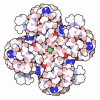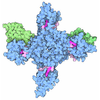+ Open data
Open data
- Basic information
Basic information
| Entry | Database: PDB / ID: 9dkf | ||||||
|---|---|---|---|---|---|---|---|
| Title | Ca2+ bound aplysia Slo1 R202Q | ||||||
 Components Components | BK channel | ||||||
 Keywords Keywords | MEMBRANE PROTEIN / Potassium channel / calcium-activated / voltage sensor / large conductance | ||||||
| Function / homology |  Function and homology information Function and homology informationlarge conductance calcium-activated potassium channel activity / monoatomic ion channel complex / postsynaptic membrane Similarity search - Function | ||||||
| Biological species |  | ||||||
| Method | ELECTRON MICROSCOPY / single particle reconstruction / cryo EM / Resolution: 2.6 Å | ||||||
 Authors Authors | Gustavo, G.F. / Shen, R. / Latorre, R. / Perozo, E. | ||||||
| Funding support |  United States, 1items United States, 1items
| ||||||
 Citation Citation |  Journal: Nat Commun / Year: 2025 Journal: Nat Commun / Year: 2025Title: Structural basis of voltage-dependent gating in BK channels. Authors: Gustavo F Contreras / Rong Shen / Ramon Latorre / Eduardo Perozo /   Abstract: The allosteric communication between the pore domain, voltage sensors, and Ca binding sites in the calcium- and voltage-activated K channel (BK) underlies its physiological role as the preeminent ...The allosteric communication between the pore domain, voltage sensors, and Ca binding sites in the calcium- and voltage-activated K channel (BK) underlies its physiological role as the preeminent signal integrator in excitable systems. BK displays shallow voltage sensitivity with very fast gating charge kinetics, yet little is known about the molecular underpinnings of this distinctive behavior. Here, we explore the mechanistic basis of coupling between voltage-sensing domains (VSDs) and calcium sensors in Aplysia BK by locking the VSDs in their activated (R196Q and R199Q) and resting (R202Q) states, with or without calcium. Cryo-EM structures of these mutants reveal unique tilts at the S4 C-terminal end, together with large side-chain rotameric excursions of the gating charges. Notably, the VSD resting structure (R202Q) also revealed BK in its elusive, fully closed state, highlighting the reciprocal relation between calcium and voltage sensors. These structures provide a plausible path where voltage and Ca binding couple energetically and define the conformation of the pore domain and, thus, BK's full functional range. | ||||||
| History |
|
- Structure visualization
Structure visualization
| Structure viewer | Molecule:  Molmil Molmil Jmol/JSmol Jmol/JSmol |
|---|
- Downloads & links
Downloads & links
- Download
Download
| PDBx/mmCIF format |  9dkf.cif.gz 9dkf.cif.gz | 626.1 KB | Display |  PDBx/mmCIF format PDBx/mmCIF format |
|---|---|---|---|---|
| PDB format |  pdb9dkf.ent.gz pdb9dkf.ent.gz | 505.6 KB | Display |  PDB format PDB format |
| PDBx/mmJSON format |  9dkf.json.gz 9dkf.json.gz | Tree view |  PDBx/mmJSON format PDBx/mmJSON format | |
| Others |  Other downloads Other downloads |
-Validation report
| Summary document |  9dkf_validation.pdf.gz 9dkf_validation.pdf.gz | 1.2 MB | Display |  wwPDB validaton report wwPDB validaton report |
|---|---|---|---|---|
| Full document |  9dkf_full_validation.pdf.gz 9dkf_full_validation.pdf.gz | 1.2 MB | Display | |
| Data in XML |  9dkf_validation.xml.gz 9dkf_validation.xml.gz | 95.2 KB | Display | |
| Data in CIF |  9dkf_validation.cif.gz 9dkf_validation.cif.gz | 147.8 KB | Display | |
| Arichive directory |  https://data.pdbj.org/pub/pdb/validation_reports/dk/9dkf https://data.pdbj.org/pub/pdb/validation_reports/dk/9dkf ftp://data.pdbj.org/pub/pdb/validation_reports/dk/9dkf ftp://data.pdbj.org/pub/pdb/validation_reports/dk/9dkf | HTTPS FTP |
-Related structure data
| Related structure data |  46956MC  9di8C  9dicC  9ditC  9djvC  9dklC  9dknC M: map data used to model this data C: citing same article ( |
|---|---|
| Similar structure data | Similarity search - Function & homology  F&H Search F&H Search |
- Links
Links
- Assembly
Assembly
| Deposited unit | 
|
|---|---|
| 1 |
|
- Components
Components
| #1: Protein | Mass: 119684.297 Da / Num. of mol.: 4 / Mutation: T2A, R202Q Source method: isolated from a genetically manipulated source Source: (gene. exp.)  Production host:  #2: Chemical | ChemComp-K / #3: Chemical | ChemComp-MG / #4: Chemical | ChemComp-CA / Has ligand of interest | Y | Has protein modification | N | |
|---|
-Experimental details
-Experiment
| Experiment | Method: ELECTRON MICROSCOPY |
|---|---|
| EM experiment | Aggregation state: PARTICLE / 3D reconstruction method: single particle reconstruction |
- Sample preparation
Sample preparation
| Component | Name: homotetramer large-conductance calcium- and voltage-activated K+ channel Type: COMPLEX / Entity ID: #1 / Source: RECOMBINANT |
|---|---|
| Source (natural) | Organism:  |
| Source (recombinant) | Organism:  |
| Buffer solution | pH: 8 |
| Specimen | Embedding applied: NO / Shadowing applied: NO / Staining applied: NO / Vitrification applied: YES |
| Vitrification | Cryogen name: ETHANE |
- Electron microscopy imaging
Electron microscopy imaging
| Experimental equipment |  Model: Titan Krios / Image courtesy: FEI Company |
|---|---|
| Microscopy | Model: FEI TITAN KRIOS |
| Electron gun | Electron source:  FIELD EMISSION GUN / Accelerating voltage: 300 kV / Illumination mode: OTHER FIELD EMISSION GUN / Accelerating voltage: 300 kV / Illumination mode: OTHER |
| Electron lens | Mode: DIFFRACTION / Nominal defocus max: 2200 nm / Nominal defocus min: 500 nm |
| Image recording | Electron dose: 65 e/Å2 / Film or detector model: GATAN K3 BIOQUANTUM (6k x 4k) |
- Processing
Processing
| CTF correction | Type: PHASE FLIPPING AND AMPLITUDE CORRECTION |
|---|---|
| 3D reconstruction | Resolution: 2.6 Å / Resolution method: FSC 0.143 CUT-OFF / Num. of particles: 500000 / Symmetry type: POINT |
| Atomic model building | Protocol: FLEXIBLE FIT |
 Movie
Movie Controller
Controller









 PDBj
PDBj







